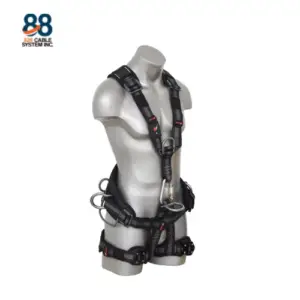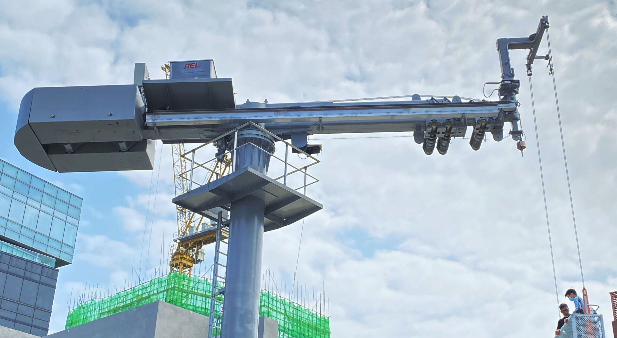Workplace safety should never be an afterthought, especially in high-risk environments such as construction sites, manufacturing plants, maintenance platforms, and elevated work zones. Among the various personal protective equipment (PPE) used to reduce workplace accidents, the Full – Body Harness stands out as a critical component in fall protection systems.
Workers who perform duties at height are always at risk of falling. A properly selected and correctly worn full – body harness can mean the difference between life and death. This comprehensive guide delves into what a full – body harness is, how it functions, its key features, and why it’s indispensable for worker safety.
What Is a Full – Body Harness?
A Full – Body Harness is a safety device worn around the body to prevent or arrest falls from height. Unlike a simple body belt or chest harness, it distributes fall forces across the shoulders, thighs, chest, and pelvis. This equal distribution ensures that the force of a fall does not concentrate on a single area of the body, which could cause severe injury.
Typically used in fall arrest systems, a full – body harness is designed to work in tandem with other protective equipment like anchor points, lanyards, and self-retracting lifelines. It’s a common sight in industries such as construction, telecommunications, tower climbing, wind energy, warehousing, and rescue operations.
Key Components of a Full – Body Harness
Understanding the components of a Full – Body Harness helps users ensure proper wear and optimal performance:
- D-Rings: Located on the back (dorsal), chest, sides, or waist, D-rings are attachment points for lifelines or lanyards. The dorsal D-ring is the most commonly used in fall arrest systems.
- Shoulder Straps: Run over the shoulders to hold the harness in place and maintain balance.
- Chest Strap: Positioned across the chest to prevent the harness from shifting during movement or in the event of a fall.
- Leg Straps: Wrap around the upper legs to support body weight during suspension.
- Adjustable Buckles: Allow for a customized fit. They can be quick-connect, pass-through, or tongue buckles depending on user preference and job requirements.
- Padding: Added for enhanced comfort, especially during long-duration wear.
- Inspection Labels and Tags: Display manufacturing details, inspection logs, and compliance certification.
Each component is engineered to work in harmony, ensuring that the user remains secure and upright during a fall event.
How a Full – Body Harness Works
The Full – Body Harness is not a standalone solution—it’s part of an integrated fall arrest system. When used with a self-retracting lanyard (SRL) or standard shock-absorbing lanyard, it ensures that a falling worker is quickly and safely brought to a stop.
If a fall occurs, the attached lifeline or lanyard—secured to an anchor point—activates. In the case of an SRL, the braking mechanism engages instantly, reducing the fall distance and dispersing force throughout the full – body harness. This immediate response not only prevents the worker from hitting the ground but also reduces the risk of internal injuries caused by arresting forces.
Additionally, the harness maintains an upright suspension, crucial for reducing the dangers of suspension trauma, which can occur if a person hangs motionless for too long.
Benefits of Using a Full – Body Harness
Employing a Full – Body Harness in your fall protection program offers multiple benefits:
- Enhanced Safety: It’s the most reliable method to prevent serious injury or fatality from falls.
- Balanced Weight Distribution: By spreading force across multiple parts of the body, it minimizes the risk of concentrated trauma.
- Regulatory Compliance: Meets OSHA, ANSI, and other local safety standards.
- Versatility: Usable across a wide range of industries and roles, including roofing, rigging, welding at height, and rescue missions.
- Mobility: When properly adjusted, it provides secure movement and flexibility, enabling efficient work at height.
Proper Fitting and Usage Guidelines
To maximize the protection offered by a Full – Body Harness, proper usage is essential:
Step-by-Step Fitting:
- Inspect the harness for any damage before wearing.
- Hold the dorsal D-ring and shake the harness to untangle the straps.
- Step into the leg straps, just like putting on pants.
- Pull the shoulder straps over your shoulders.
- Fasten and tighten the chest strap until snug.
- Secure leg straps—they should be tight but not restrict movement.
- Adjust buckles so that all straps lie flat and are comfortable.
Common Fitting Mistakes:
- Wearing the harness too loose
- Misaligned chest strap
- Twisted leg or shoulder straps
- Failure to properly engage the buckles
Training and hands-on practice are essential to ensure all users know how to don and adjust the harness correctly.
Choosing the Right Full – Body Harness for the Job
Several factors influence the selection of a Full – Body Harness:
- Work Environment: Harnesses for welding, for example, should be flame-resistant.
- Application: Tower climbing harnesses often feature extra padding and more D-rings.
- Duration of Use: Long-wear jobs may require padded harnesses for comfort.
- Weight Capacity: Ensure the harness meets the required capacity, especially for users with heavy tools.
Check for compliance with standards such as OSHA 1926.502 or ANSI Z359 before purchasing. Look for brands that provide strong after-sales support, training, and certification.
Full – Body Harness vs. Other Fall Protection Gear
While a Full – Body Harness is central to fall protection, it works best when combined with:
- Self-Retracting Lanyards (SRLs): Automatically brake during a fall.
- Shock-Absorbing Lanyards: Extend fall distance but reduce impact force.
- Anchor Points: Connect the harness to a secure structure.
- Rescue Equipment: Allows for safe retrieval after a fall.
A complete fall arrest system is only as strong as its weakest link. Ensuring each component is compatible and properly installed is key to effective fall protection.
Legal and Compliance Requirements
Workplace safety regulations worldwide mandate the use of a Full – Body Harness in fall-prone jobs. In the Philippines and many other countries, compliance with:
- Department of Labor and Employment (DOLE) guidelines
- OSHA 1926 Subpart M
- ANSI/ASSE Z359 fall protection codes
…is not optional—it’s a legal obligation. Employers must provide appropriate PPE, ensure training, and maintain detailed inspection records.
Common Misconceptions About Full – Body Harnesses
Let’s debunk some frequent myths:
- “Any harness will do” – Harnesses are application-specific. One for scaffolding may not suit confined space rescue.
- “One-size-fits-all” – Proper sizing matters. Ill-fitting harnesses can fail in an actual fall.
- “It’s okay to share harnesses” – This increases wear-and-tear and raises hygiene concerns.
Education is key to combating these unsafe assumptions.
Takeaway
The Full – Body Harness is a life-saving tool that no worker at height should be without. Its ability to evenly distribute fall forces, work in coordination with SRLs and anchor systems, and offer reliable performance makes it the foundation of any effective fall protection plan.
By choosing the right harness, ensuring proper fitting and inspection, and integrating it into a complete safety system, both employers and workers can dramatically reduce the risks of working at heights. Safety isn’t just a regulation—it’s a responsibility.











